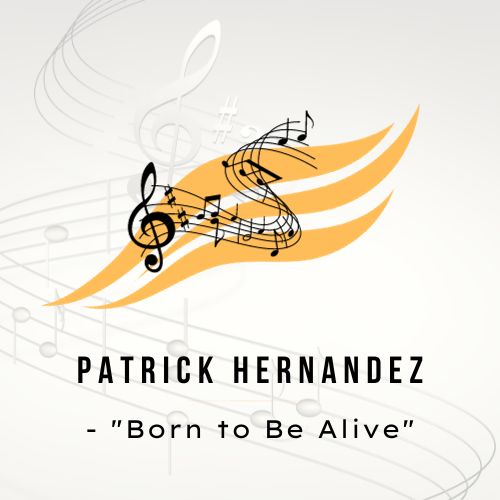Introduction to Patrick Hernandez
Patrick Hernandez is a French singer known for his international disco hit “Born To Be Alive” in 1979. Hernandez’s interest in music led him to perform in groups who performed in local events in southern France. Along with his collaborator Herve Tholace, Hernandez would provide backups with French musicians such as Francis Cabrel, Laurent Voulzy, and Gold (a musical group). Thanks to the popularity of disco at that time, Hernandez eventually scored a big hit with “Born To Be Alive”, which was originally released in France. It caught rapid attention in Europe, and then finally in the United States, where the song was remixed before releasing it as a single. “Born To Be Alive” became a Top 20 hit, and #1 on the dance/disco charts in 1979. While his other subsequent releases did poorly on the charts, “Born To Be Alive” has sold close to a million units under various formats and compilations since its first release.
Early life and career
Patrick Hernandez is a French singer-songwriter, born in Le Blanc-Mesnil, Seine-Saint-Denis, France on April 6, 1949. He was born to a Spanish father and Australian/Italian mother; he also grew up in the place where he was born.
Like many other adolescent, Hernandez was hooked on music. Soon he started to form his own band, and over the next decade Hernandez was struggling to build his own name through joining with different bands as well as playing in dance and disco halls in southern France.
During this period Hernandez met singer, guitarist and arranger Herve Tholance who would become his musical partner. Together the duo started to achieve local success backing up France’s current stars such as Frances Cabrel, Laurent Voulzy and the popular act Gold, among others.
In 1978 Hernandez met and started to collaborate with producer Jean Vanloo. With disco reaching at the peak of its popularity and spawning off stars such as disco musician Jean-Marc Cerrone, Hernandez decided that it was time to incorporate disco into his rock music foundation. He grabbed the opportunity by signing a recording contract; Hernandez then went to Waterloo, Belgium to begin experimenting with writing and recording songs.
“Born to Be Alive” — a global disco hit
After almost a year’s work, Hernandez produced six songs which were eventually released on Aquarius Records’ subsidiary label Aariana (in France) in November 1978. One of these songs were hard-edged disco rock tune “Born to Be Alive” — the record that would change Hernandez’s life dramatically.
“Born to Be Alive” became a big hit, first in France where the song rose to #1. Soon the song became popular in other parts of Europe and remained so for many months; he received his first gold record in Italy. In the United Kingdom, the song reached its peak position at #10.
Soon the United States got wind of “Born to Be Alive” uproar from Europe. The song was then remixed and released on Columbia label. “Born to Be Alive” went on to become a Billboard Top 20 pop hit at #16, and topped the Billboard dance chart in 1979. The success of “Born to Be Alive” made Patrick Hernandez a global star.
Patrick Hernandez’s involvement with Madonna’s early career
For his United States tour, Hernandez was escorted by Vanloo and his friend Jean-Claude Pellerin, who held auditions in New York for aspiring dancers to join Hernandez in his global tour. One of these aspiring dancers was the young Madonna. However, Hernandez and company saw that she was having more “punch” than the other dancers, so they separated her from the other hopefuls. They even wanted to send her to France and train her to be a singer. Madonna, on the other hand, had no interest to become a singer and only wanted to be a dancer all her life. Despite this, she accepted the offer to go to Paris.
While in Paris, Hernandez took a liking to Madonna that he wanted to help her boost her career. But Madonna was dissatisfied on the slow progress that Hernandez’s managers were making with her, as well as the material meant to be given to the future pop star (including a song called “She’s a Real Disco Queen,” which she turned down). After only three months, Madonna fled Paris and returned to New York. On her own, she worked her way to become the global superstar that she is today.
Hernandez’s later career, and “Born to Be Alive”‘s commercial impact
Although the follow-ups to “Born to Be Alive” fared poorly (such as “Disco Queen” which was only a minor dance hit), “Born to Be Alive” otherwise sold quite well, leading to Hernandez winning the Billboard award in early 1980. Through the success of the single, Hernandez had received 52 gold and platinum records from several countries.
Throughout the 1980s and the 1990s Hernandez toured and enjoyed occasional appearances on other artists’ recordings in Europe. A re-remix of his hit “Born to Be Alive” loomed in nightclubs in the mid-1980s; the song was featured in the fourth installment of National Lampoon Vacation film comedy series as well.
In 1999, in celebration of “Born to Be Alive”‘s 20 years, The Best of Patrick Hernandez was issued. The album includes the original form of the song as well as the American re-mix, which was never released in Europe.
Since its original release in 1978, “Born to Be Alive” the record has sold more than 800,000 units globally under various editions, forms and compilations. It’s being said that the legendary disco track has brought in about $25 million worldwide.
